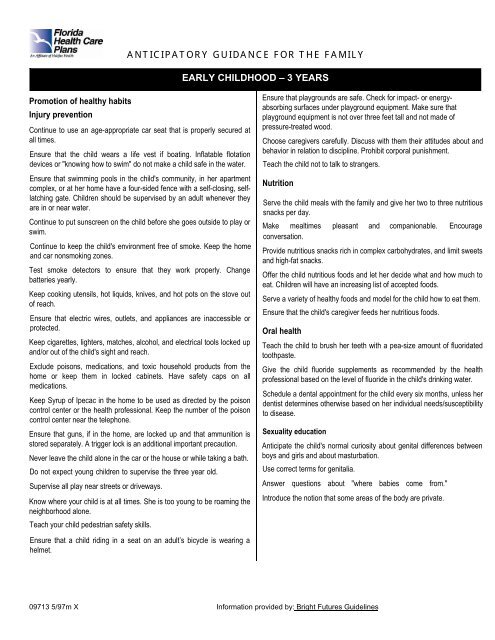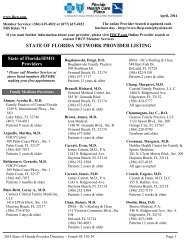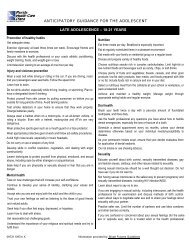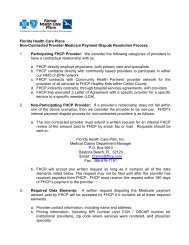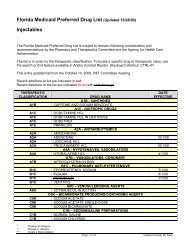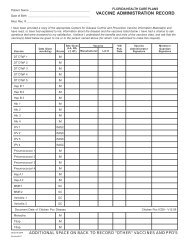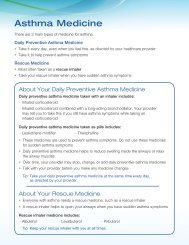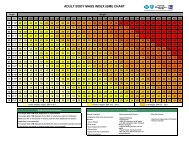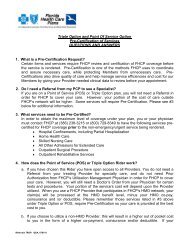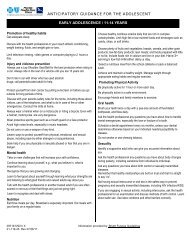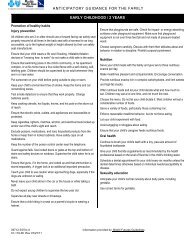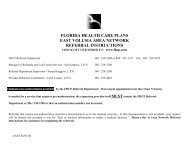anticipatory guidance for the family early childhood – 3 years
anticipatory guidance for the family early childhood – 3 years
anticipatory guidance for the family early childhood – 3 years
You also want an ePaper? Increase the reach of your titles
YUMPU automatically turns print PDFs into web optimized ePapers that Google loves.
ANTICIPATORY GUIDANCE FOR THE FAMILY<br />
INFANCY - PRENATAL<br />
EARLY CHILDHOOD <strong>–</strong> 3 YEARS<br />
Promotion of healthy habits<br />
Injury prevention<br />
Continue to use an age-appropriate car seat that is properly secured at<br />
all times.<br />
Ensure that <strong>the</strong> child wears a life vest if boating. Inflatable flotation<br />
devices or "knowing how to swim" do not make a child safe in <strong>the</strong> water.<br />
Ensure that swimming pools in <strong>the</strong> child's community, in her apartment<br />
complex, or at her home have a four-sided fence with a self-closing, selflatching<br />
gate. Children should be supervised by an adult whenever <strong>the</strong>y<br />
are in or near water.<br />
Continue to put sunscreen on <strong>the</strong> child be<strong>for</strong>e she goes outside to play or<br />
swim.<br />
Continue to keep <strong>the</strong> child's environment free of smoke. Keep <strong>the</strong> home<br />
and car nonsmoking zones.<br />
Test smoke detectors to ensure that <strong>the</strong>y work properly. Change<br />
batteries y<strong>early</strong>.<br />
Keep cooking utensils, hot liquids, knives, and hot pots on <strong>the</strong> stove out<br />
of reach.<br />
Ensure that electric wires, outlets, and appliances are inaccessible or<br />
protected.<br />
Keep cigarettes, lighters, matches, alcohol, and electrical tools locked up<br />
and/or out of <strong>the</strong> child's sight and reach.<br />
Exclude poisons, medications, and toxic household products from <strong>the</strong><br />
home or keep <strong>the</strong>m in locked cabinets. Have safety caps on all<br />
medications.<br />
Keep Syrup of Ipecac in <strong>the</strong> home to be used as directed by <strong>the</strong> poison<br />
control center or <strong>the</strong> health professional. Keep <strong>the</strong> number of <strong>the</strong> poison<br />
control center near <strong>the</strong> telephone.<br />
Ensure that guns, if in <strong>the</strong> home, are locked up and that ammunition is<br />
stored separately. A trigger lock is an additional important precaution.<br />
Never leave <strong>the</strong> child alone in <strong>the</strong> car or <strong>the</strong> house or while taking a bath.<br />
Do not expect young children to supervise <strong>the</strong> three year old.<br />
Supervise all play near streets or driveways.<br />
Know where your child is at all times. She is too young to be roaming <strong>the</strong><br />
neighborhood alone.<br />
Teach your child pedestrian safety skills.<br />
Ensure that playgrounds are safe. Check <strong>for</strong> impact- or energyabsorbing<br />
surfaces under playground equipment. Make sure that<br />
playground equipment is not over three feet tall and not made of<br />
pressure-treated wood.<br />
Choose caregivers carefully. Discuss with <strong>the</strong>m <strong>the</strong>ir attitudes about and<br />
behavior in relation to discipline. Prohibit corporal punishment.<br />
Teach <strong>the</strong> child not to talk to strangers.<br />
Nutrition<br />
Serve <strong>the</strong> child meals with <strong>the</strong> <strong>family</strong> and give her two to three nutritious<br />
snacks per day.<br />
Make mealtimes pleasant and companionable. Encourage<br />
conversation.<br />
Provide nutritious snacks rich in complex carbohydrates, and limit sweets<br />
and high-fat snacks.<br />
Offer <strong>the</strong> child nutritious foods and let her decide what and how much to<br />
eat. Children will have an increasing list of accepted foods.<br />
Serve a variety of healthy foods and model <strong>for</strong> <strong>the</strong> child how to eat <strong>the</strong>m.<br />
Ensure that <strong>the</strong> child's caregiver feeds her nutritious foods.<br />
Oral health<br />
Teach <strong>the</strong> child to brush her teeth with a pea-size amount of fluoridated<br />
toothpaste.<br />
Give <strong>the</strong> child fluoride supplements as recommended by <strong>the</strong> health<br />
professional based on <strong>the</strong> level of fluoride in <strong>the</strong> child's drinking water.<br />
Schedule a dental appointment <strong>for</strong> <strong>the</strong> child every six months, unless her<br />
dentist determines o<strong>the</strong>rwise based on her individual needs/susceptibility<br />
to disease.<br />
Sexuality education<br />
Anticipate <strong>the</strong> child's normal curiosity about genital differences between<br />
boys and girls and about masturbation.<br />
Use correct terms <strong>for</strong> genitalia.<br />
Answer questions about "where babies come from."<br />
Introduce <strong>the</strong> notion that some areas of <strong>the</strong> body are private.<br />
Ensure that a child riding in a seat on an adult’s bicycle is wearing a<br />
helmet.<br />
09713 5/97m X In<strong>for</strong>mation provided by: Bright Futures Guidelines
ANTICIPATORY GUIDANCE FOR THE FAMILY<br />
EARLY CHILDHOOD <strong>–</strong> 3 YEARS<br />
Promotion of social competence<br />
Praise <strong>the</strong> child <strong>for</strong> good behavior and accomplishments.<br />
Encourage <strong>the</strong> child to talk with you about her preschool, friends, or<br />
observations. Answer her questions.<br />
Encourage interactive reading with <strong>the</strong> child.<br />
Spend individual time with <strong>the</strong> child, doing something you both enjoy.<br />
Provide opportunities <strong>for</strong> exploration.<br />
Provide opportunities <strong>for</strong> <strong>the</strong> three year old to socialize with o<strong>the</strong>r<br />
children in play groups, preschool, or o<strong>the</strong>r community activities.<br />
Promote physical activity in a safe environment.<br />
Give <strong>the</strong> child opportunities to make choices (e.g. which clo<strong>the</strong>s to wear,<br />
books to read, places to go).<br />
Rein<strong>for</strong>ce limits and appropriate behavior. Try to be consistent in<br />
expectations and discipline.<br />
Use time out or remove source of conflict <strong>for</strong> unacceptable behavior.<br />
Encourage self-discipline.<br />
Anticipate that your child may have many fears, including night terrors.<br />
Limit television watching to an average of one hour per day of<br />
appropriate programs. Watch <strong>the</strong> programs toge<strong>the</strong>r and discuss <strong>the</strong>m.<br />
Promotion of constructive <strong>family</strong> relationships and<br />
parental health<br />
If ano<strong>the</strong>r baby is expected, discuss with <strong>the</strong> health professional how to<br />
prepare <strong>the</strong> three-year-old child <strong>for</strong> <strong>the</strong> new baby.<br />
Spend some time playing with <strong>the</strong> child each day. Focus on activities<br />
that she expresses interest in and enjoys.<br />
Listen to and show respect <strong>for</strong> <strong>the</strong> child.<br />
Show interest in preschool and/or child care activities.<br />
Show affection in <strong>the</strong> <strong>family</strong>.<br />
Spend some individual time with each child.<br />
Participate in games and o<strong>the</strong>r activities with <strong>the</strong> child.<br />
Encourage <strong>the</strong> development of good sibling relationships. Acknowledge<br />
conflicts between siblings. Whenever possible, attempt to resolve<br />
conflicts without taking sides. Do not allow hitting, biting, or o<strong>the</strong>r violent<br />
behavior.<br />
Share meals as a <strong>family</strong> whenever possible. Spend time talking to each<br />
o<strong>the</strong>r.<br />
Handle anger constructively in <strong>the</strong> <strong>family</strong>.<br />
Discuss with <strong>the</strong> health professional your own preventive and healthpromoting<br />
practices (e.g., using seat belts, avoiding tobacco, eating<br />
properly, exercising and doing breast self-exams or testicular selfexams).<br />
Promotion of community interactions<br />
Ask about resources or referrals <strong>for</strong> food (e.g. WIC), housing, or<br />
transportation if needed.<br />
Discuss with <strong>the</strong> health professional possible programs <strong>for</strong> your child:<br />
preschools, <strong>early</strong> intervention programs, Head Start (most programs<br />
start at age four), swimming and o<strong>the</strong>r exercise programs, or o<strong>the</strong>r<br />
community programs.<br />
Learn about and consider attending parent education classes or parent<br />
support groups.<br />
Maintain or expand ties to your community through social, religious,<br />
cultural, volunteer, and recreational organizations.<br />
Discuss with <strong>the</strong> health professional choosing and evaluating child care<br />
programs. Discuss <strong>the</strong> child care arrangements you have made.<br />
Find out what you can do to make your community safer. Advocate <strong>for</strong><br />
and participate in a neighborhood watch program.<br />
09713 5/97m X In<strong>for</strong>mation provided by: Bright Futures Guidelines


